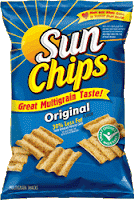Subway counters have recently begun displaying a laminated card with nutrition information for their "NEW 9-Grain With Omega 3 (ALA)" bread. With all the added omega-3 ALA, is this bread any healthier than their traditional wheat bread?
First of all - don't be fooled by any omega-3 product that touts the benefits of ALA (alpha-linolenic acid). Food manufacturers want you to confuse ALA with the two healthier types of omega-3 fatty acids: EPA & DHA. EPA & DHA are found in fatty fish like salmon and trout and fish oil capsules and have demonstrated positive effects on brain and neurological development.
The American Heart Association recommends an average of 400-500 mg EPA + DHA per day for people without heart disease and 1,000 mg for people with heart disease. Eating 2-3 servings of fish per week averages out to somewhere between 500-1,000 mg EPA + DHA per day; people who don't eat fish should consider getting their EPA + DHA from fish oil capsules.
ALA is the type of omega-3 found in flax, soy, and canola; it's a shorter-chain fatty acid that no doubt has health benefits, but not nearly the beneficial effects of EPA & DHA. Our bodies convert very little ALA to EPA and no ALA to DHA. So the bottom line is, most people stand to benefit from increasing the amount of EPA + DHA in their diets but don't have to worry about increasing ALA which is found in adequate amounts in most people's diets.
There's no nutritional information on this new bread on
Subway's website, but the posters at Subway say a 230 calorie 6" serving has 4 grams of fiber and 500 mg of ALA, with no mention of EPA + DHA (the only type of omega-3 fatty acids you probably should be consuming more of). The highest fiber traditional sandwich bread at Subway is a 6" Honey-Oat bread has 280 calories and 5 grams of fiber. There are no 100% whole wheat options in 6" size; but, for a lot less calories, the
Subway breakfast sandwiches on English Muffins have 5 grams of fiber.
And, despite some of Subway's nutritional shortcomings, they do have a sweet custom gift card you can design on their website with your own photo. To check it out:
click here.






